limnidytis
Member
Lately I've been too busy with work work to do much with photography. Really depressing. But late at night a couple of days ago, I was sitting in the basement (AKA the darkroom) thinking what could I do. Inspired by other similar undertakings, I decided to make a film can camera. I have a lot of empty film cans, so I drilled a 3/8 hole in the middle of a black can with a wood bit. I used heavy duty aluminum foil and made a hole with a 30 gauge needle - the smallest I could find in my workbench. The film can has a 31mm focal length. Using one of the online calculators, the "camera" should have a 0.221 mm pinhole. A 30 gauge needle is 0.3112 mm in diameter - much too big - but why obsess about small details. The 30 gauge hole equals a F99. The 30 gauge hypodermic needle I used has a very long, sharp bevel on the tip so it mostly cut a slit in the foil rather than punching a hole, but again why worry? The shutter was a high tech piece of black tape. I have some Arista Ortho Litho film, which I cut into a 1.75x2in piece that covered about 1/2 of the inner diameter of the can. So I loaded the "camera", opened the shutter, and turned the lights on. And then I waited. For 2 days. The calculated exposure time for F99 and ISO 3 was about 6 hours. The overhead lights were probably on 6-8 hours and otherwise the safe lights or no lights were on. I developed the film in Selectol Soft 1+9 and got actually a pretty good negative. I was shocked to see that the image has good contrast. In my experience, pinhole photos tend to be low contrast - from flare in the camera, I assume. Maybe the higher contrast litho film actually made the contrast better. To stress the system more, I contact printed the negative onto very old fogged Kodak Polycontrast RC paper. It actually worked out shockingly well. It's interesting that in the middle top of the image there is a very bright Thomas safelight that was on some of the time but the light didn't show up in the image at all. I guess it really is safe.
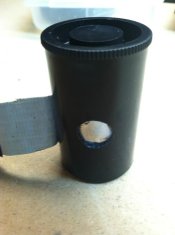
The "Camera"
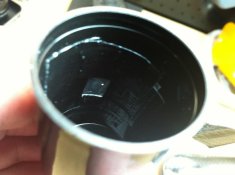
The "Lens"
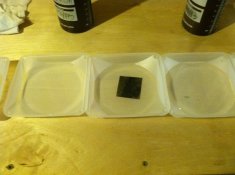
Developing in weighing boats
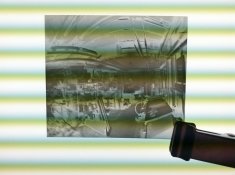
The "Negative". My iPhone sees bands on my lightbox- maybe it's a shutter/flicker artifact.
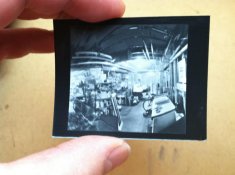
The "Image"
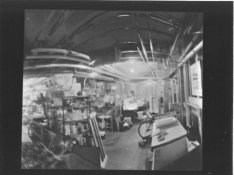
Scanned Image. Not bad for extreme low tech.

The "Camera"

The "Lens"

Developing in weighing boats

The "Negative". My iPhone sees bands on my lightbox- maybe it's a shutter/flicker artifact.

The "Image"

Scanned Image. Not bad for extreme low tech.






